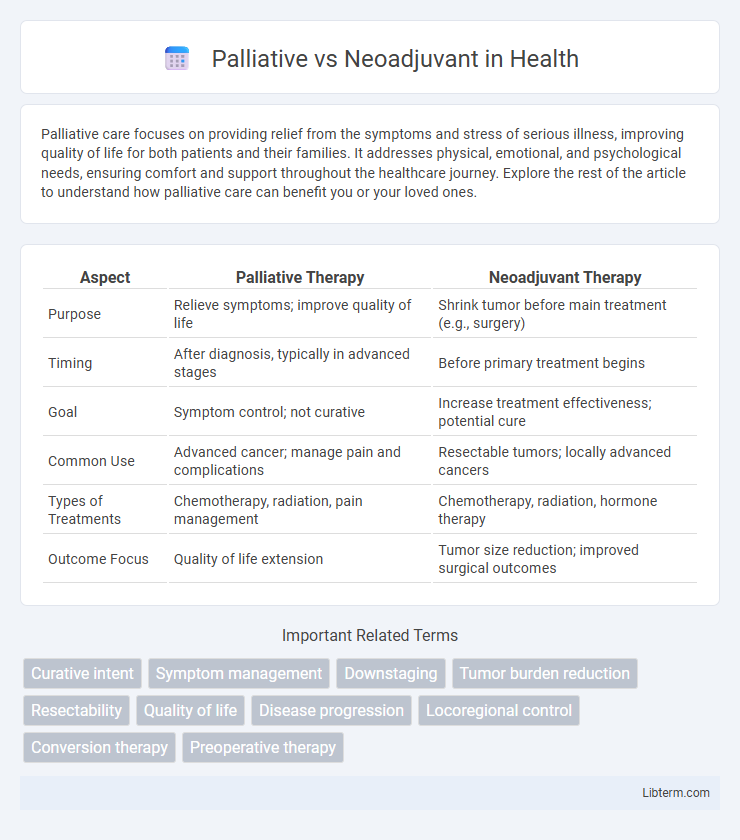Palliative care focuses on providing relief from the symptoms and stress of serious illness, improving quality of life for both patients and their families. It addresses physical, emotional, and psychological needs, ensuring comfort and support throughout the healthcare journey. Explore the rest of the article to understand how palliative care can benefit you or your loved ones.
Table of Comparison
| Aspect | Palliative Therapy | Neoadjuvant Therapy |
|---|---|---|
| Purpose | Relieve symptoms; improve quality of life | Shrink tumor before main treatment (e.g., surgery) |
| Timing | After diagnosis, typically in advanced stages | Before primary treatment begins |
| Goal | Symptom control; not curative | Increase treatment effectiveness; potential cure |
| Common Use | Advanced cancer; manage pain and complications | Resectable tumors; locally advanced cancers |
| Types of Treatments | Chemotherapy, radiation, pain management | Chemotherapy, radiation, hormone therapy |
| Outcome Focus | Quality of life extension | Tumor size reduction; improved surgical outcomes |
Understanding Palliative vs Neoadjuvant Therapies
Palliative therapy aims to relieve symptoms and improve quality of life for patients with advanced or incurable diseases, without targeting the primary tumor for eradication. Neoadjuvant therapy is administered before the main treatment, typically surgery, to shrink tumors, enhance resectability, and improve overall outcomes. Understanding the distinct goals and timing of palliative and neoadjuvant therapies is crucial for optimizing cancer management strategies.
Defining Palliative Therapy in Oncology
Palliative therapy in oncology focuses on relieving symptoms and improving quality of life for patients with advanced or incurable cancer rather than attempting to cure the disease. It involves interventions such as pain management, symptom control, and psychosocial support tailored to the patient's needs. Unlike neoadjuvant therapy, which is given before primary treatment to shrink tumors or improve surgical outcomes, palliative therapy aims primarily at comfort and symptom relief.
What is Neoadjuvant Therapy?
Neoadjuvant therapy refers to treatments, such as chemotherapy, radiation, or hormone therapy, given before the main surgical intervention to shrink tumors and improve surgical outcomes. It aims to reduce tumor size, making cancer more operable and increasing the chances of complete removal. This preoperative approach often enhances long-term survival rates compared to surgery alone.
Goals: Palliative vs Neoadjuvant Approaches
Palliative treatment aims to relieve symptoms and improve quality of life for patients with advanced cancer, focusing on pain management, symptom control, and enhancing comfort. Neoadjuvant therapy is designed to shrink tumors before primary treatment, such as surgery or radiation, increasing the likelihood of complete tumor removal and improving long-term survival outcomes. The primary goal of palliative care is symptom relief without intent to cure, whereas neoadjuvant therapy seeks to improve curative potential by reducing tumor burden preoperatively.
Common Indications for Each Treatment
Palliative treatment is commonly indicated for advanced or metastatic cancers where the primary goal is symptom relief and quality of life improvement, often used in cases like late-stage lung, pancreatic, or brain tumors. Neoadjuvant therapy is typically indicated for resectable tumors such as breast, rectal, or esophageal cancers to shrink tumors preoperatively, enhancing surgical outcomes and increasing the chance of complete resection. Both treatments play critical roles in oncology but serve distinct purposes based on cancer stage and treatment goals.
Timing and Sequence in Cancer Care
Palliative therapy is administered primarily to relieve symptoms and improve quality of life during advanced stages of cancer, often following initial treatments or when curative intent is no longer feasible. Neoadjuvant therapy, delivered before the main treatment like surgery, aims to shrink tumors and enhance the effectiveness of subsequent interventions. The timing and sequence differ markedly, with neoadjuvant approaches positioned early in the treatment plan and palliative care integrated later to address symptom management and patient comfort.
Treatment Modalities: Drugs, Radiation, Surgery
Palliative treatment focuses on relieving symptoms and improving quality of life using low-dose radiation, analgesic drugs, and minimally invasive surgeries to manage pain and tumor burden without aiming for cure. Neoadjuvant therapy involves high-dose chemotherapy and radiation administered before surgery to shrink tumors, increasing the likelihood of complete resection and improving long-term survival outcomes. Surgical approaches in neoadjuvant settings are typically more extensive, aiming for curative intent, while palliative surgery targets symptom relief and functional improvement.
Patient Selection Criteria
Palliative treatment is selected primarily for patients with advanced or metastatic cancer who aim to relieve symptoms and improve quality of life rather than achieve curative outcomes. Neoadjuvant therapy is indicated for patients with localized, potentially resectable tumors to reduce tumor size or stage before surgical intervention. Key patient selection criteria for neoadjuvant therapy include tumor biology, staging, and overall fitness for surgery, whereas palliative care focuses on symptom burden, performance status, and patient goals.
Outcomes and Prognosis Comparison
Palliative therapy primarily aims to relieve symptoms and improve quality of life in advanced-stage cancers, often resulting in limited survival extension. Neoadjuvant treatment, given before the main therapy like surgery, enhances tumor resectability and can improve long-term prognosis by reducing recurrence rates. Studies show neoadjuvant approaches typically correlate with better overall survival outcomes compared to palliative care, which is largely supportive rather than curative.
Side Effects and Quality of Life Considerations
Palliative treatment primarily aims to relieve symptoms and improve quality of life for patients with advanced cancer, often involving fewer side effects compared to aggressive therapies. Neoadjuvant therapy, given before the main treatment like surgery, can cause more intense side effects such as fatigue, nausea, and immune suppression but may also increase the chance of successful tumor removal. Quality of life considerations in palliative care emphasize comfort and symptom management, whereas neoadjuvant treatment balances side effects against potential long-term survival benefits.
Palliative Infographic

 libterm.com
libterm.com